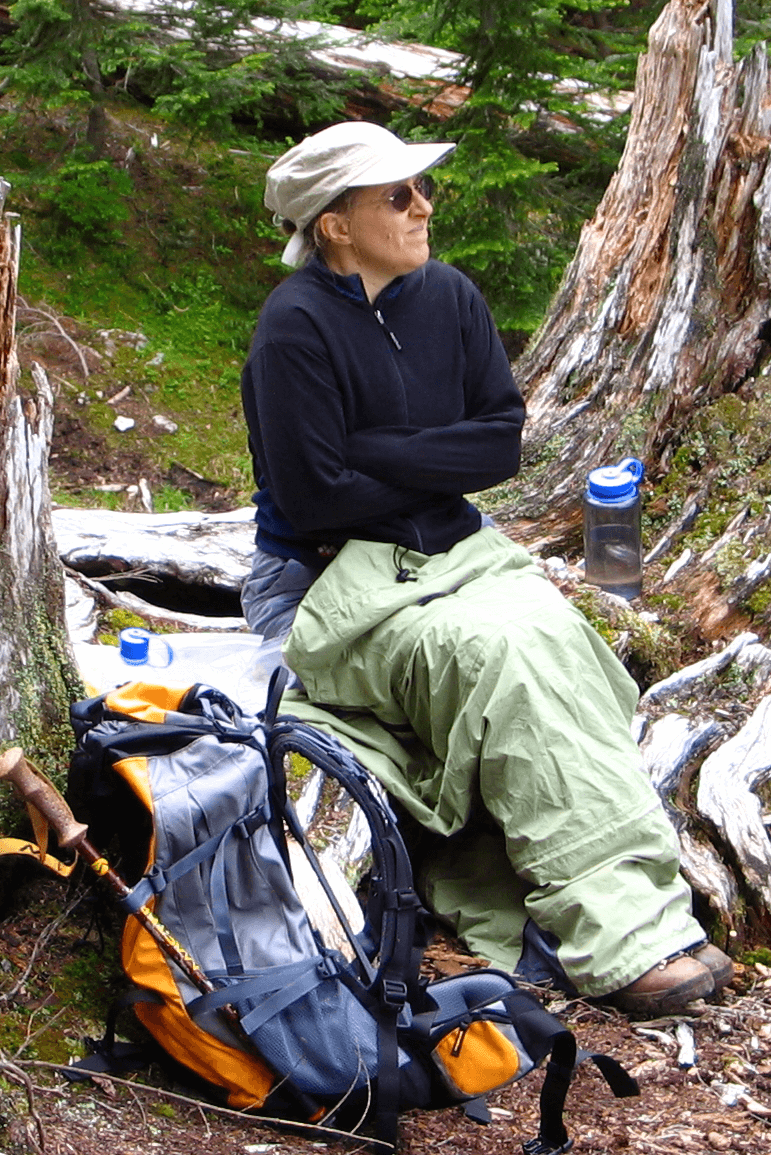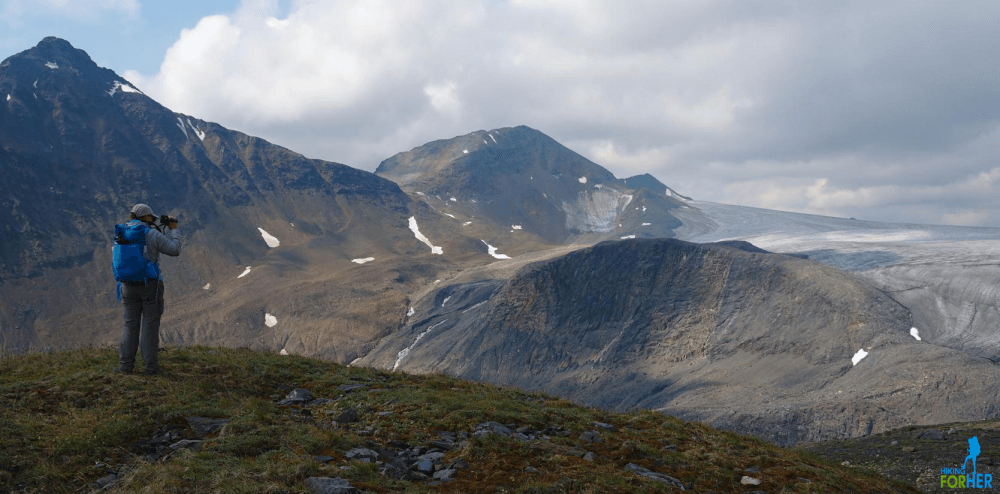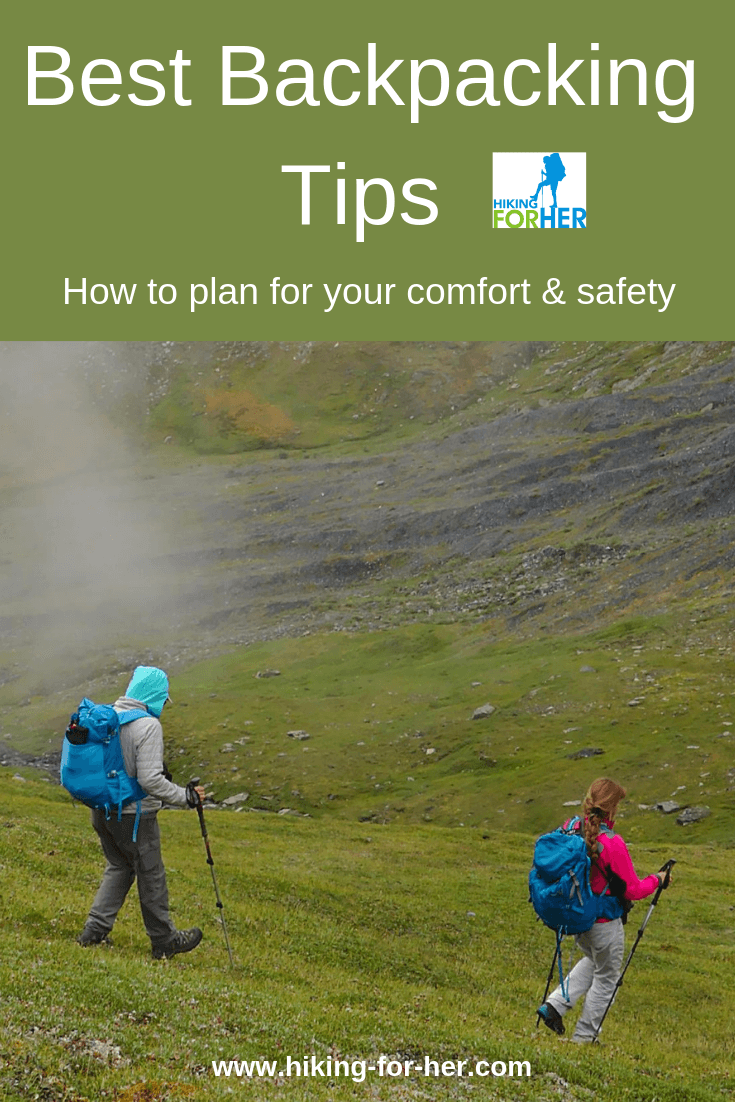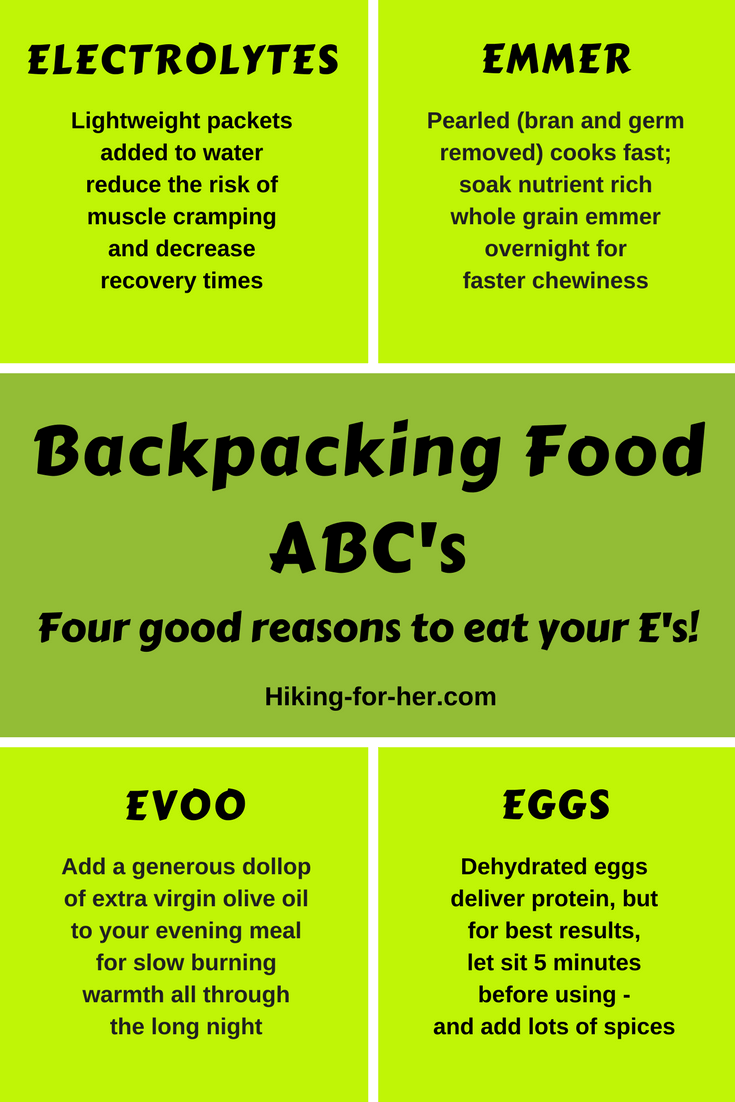
Best Backpacking Tips
For Every Skill Level
Plus Resources
By Diane Spicer
The best backpacking tips are based on extensive trail experience and an eye for detail.
You've found them!
Welcome to this Essential Guide To Backpacking, regardless of your experience level.
Best Backpacking Tips:
The Essential Guide
Table of Contents
- What being a backpacker really means
- Types of backpacking
- Backpacking destinations
- How to go backpacking for the first time
- How do you poop in the woods?
- What gear do you need for backpacking?
- What should I not bring backpacking?
- What is the best clothing for women backpackers?
- Best backpacking food selection and preparation
- Backpacking how to tips and tricks
- Safety tips for backpackers
- Backpacking comfort and hygiene tips
- Why backpacking isn't for everyone
What being a backpacker
really means
Packing everything you need on your back is the simplistic definition of a backpacker.
But you already knew that.
Let's get real.
First, the bad news
Let's get this right out into the open, shall we?
As a backpacker, you have a bit of a split personality.
- You're a hiker.
- You're a camper.
- You're two great outdoorsy women in one.
Yup, that's right!
You're a strong woman who packs her hiking gear and rugged camping equipment on her back because she loves to.
- For long distances.
- In all kinds of weather!
 Sometimes backpacking is not all sweetness and light. She could be thinking of her sore feet, her empty stomach, her tired back, or all three!
Sometimes backpacking is not all sweetness and light. She could be thinking of her sore feet, her empty stomach, her tired back, or all three!What does being (or becoming) a backpacker really mean?
It foretells that you need two strong skill sets if you want to become a competent backpacker:
- Multi-day hiking techniques to stay strong, warm, dry, hydrated and not lost
- Camping skills along the trail, including how to provide shelter, food, water, safety and comfort for yourself.
Which brings us to the good news... and why I suspect you're reading this.
Backpacking is fun!
Fun on steroids!!
(without the steroids)
You're a hiker, AND a camper, AND you're ready for anything now that you're ready to claim the badge of backpacker.
Welcome to the clan of the hefty backpacks :)
Here's the unvarnished truth
(from an -ahem- unbiased source)
A carefully packed backpacking pack, filled with everything you need for backpacking, and not an ounce of anything you don't, opens up vast horizons for you.
Freedom.
Adventure.
It's one of the most powerful things you can do as a woman.
 A photo album filled with pictures like this one is one perk any backpacker loves
A photo album filled with pictures like this one is one perk any backpacker lovesSo stick with me and read these best backpacking tips and tricks to shorten your learning curve.
Planning the perfect backpacking trip, and then enjoying every minute of it, will make you feel strong and smart and sexy.
And that's a beautiful place to be, is it not?
That's why this website is dedicated to getting you ready for multi-day backpacking adventures, and as many day hikes as you can fit into your schedule.
- Right at your fingertips, you have the best backpacking tips, gear and how to ideas, cautions and suggestions, combined into an essential guide that you can refer to again and again.
How the guide is organized
All of these backpacking tips are organized to allow you to find exactly what you need, using major categories which every backpacker needs to dial in for a successful hiking trip.
Each link in a section will take you to extensive information on that topic. It's a backpacking encyclopedia at your fingertips, all based on decades of trail experience.
- Bookmark this page so you can return again and again to keep soaking in the backpacking goodness.
Let's get started exploring the best backpacking tips.
Types of backpacking
Backpacking is like every other sport.
It has its own language, levels and techniques.
Let's unpack it.
Levels of backpacking
Backpacking skill levels are based on experience.
- In other words, how many backpacking trips you've done.
For a newbie backpacker, that number is less than 2 but could be as high as you want it to be until you reach the intermediate level.
- Backpacking essentials for beginners
- Intermediate backpacking tips
- If you're an expert level backpacker, you don't need my help!
The beauty of backpacking is that you are allowed to define your own level.
There is no international classification system, check offs or committees dictating what you need to know as a backpacker. You get to hike your own hike.
Backpacking trip categories
Another way to classify backpacking trips is to describe the length and type of trip.
A backpacker who specializes in one type of trip may claim that label to describe herself.
- "I'm a section hiker", she may say.
For instance, a trip lasting 3 days or less:
- overnight or weekend backpacking trips
- base camping
- thru-hiking (long distance hiking)
You may also see a backpacker describing how the hike is planned:
- loop hiking trips
- out and back trips
- section hiking (doing one portion of a lengthy trail system at a time)
- thru-hiking (completely a long trail in one go, sometimes involving thousands of miles)
- yo-yo hikes (turn around and retrace steps once you've reached a destination, in the opposite direction)
Number of trail buddies
One final way to talk about backpacking trips: how many people went along.
Every trip size has its advantages and disadvantages, as you can explore here:
- solo backpacking
- female hiking partner
- male hiking partner
- significant other hiking partner
- group hiking trips
Backpacking destinations
Backpackers also define themselves by the trail and the destinations they enjoy.
For example, you may hear someone refer to "the PCT" or "the Camino". Or she may say that she's a "AT-er"
Check out all of the ways a destination can be used for planning backpacking trips:
- the best long trails in the U.S.
- best destinations for hikers
- backcountry hiking
- remote hiking destinations
- off trail backpacking
- high altitude alpine hiking
- hike in lodges
- helihiking
You can focus on one particular trail, and you have a lot to choose from in North America. Here are a few famous choices:
- Appalachian Trail
- Pacific Crest Trail
- Continental Divide Trail
- Superior Trail
- Buckeye Trail
- Wonderland Trail
- West Coast Trail
- Ice Age Trail
- Yukon Hiking
How do you go backpacking
for the first time?
Congratulations!
You've asked a serious question, and that means you want to be a responsible, prepared backpacker.
The rest of this Essential Guide to the Best Backpacking Tips is exactly what you need to get started backpacking.
Work your way through each section of detailed best backpacking tips and techniques, and you'll have a successful trip!
How do you plan a backpacking trip?
Not to be a smart *ss, but the answer is "very carefully".
These tips will get you started thinking about the thought and decisions which go into planning a backpacking adventure.
How can you learn about backpacking?
There are lots of ways you can learn to be a backpacker.
You can take a group hiking vacation.
You can go on an REI Co-op backpacking adventure.
And you can take my How To Plan A Backpacking Trip course.
- Put your name on the wait list to be notified for the next opportunity. Get more details.
This guide also gives you the best backpacking tips you need to be a safe, confident backpacker, so keep reading.
How do you poop in the woods?
Actually, doing your business in the woods is a piece of cake (bad metaphor perhaps) compared to trying to poop in exposed high alpine terrain.
But we all gotta go while on a backpacking trip, so let's deal with this important question with all the facts.
You will need to plan ahead for this event, so build yourself a well stocked backpacking hygiene kit.
Here's the drill:
1. Locate a suitable spot, away from trail traffic and surface water.
2. Use a trowel to dig a cat hole well if you can.
- If you're in high alpine or a protected area, you'll use a poop bag like one of these: Restop, Biffy Bag, Wag Bag) instead.
- You need to pack these disposable bags out (see tips below).
3. Here comes the hard part: crouching over the hole.
My best tip for pooping in the woods on a backpacking trip is to build quad strength.
You need it for hiking, but those lunges really come in handy for this particular event.
Your aim is also important.
- Line yourself up before you release your sphincter muscles, or you will have to use the trowel to "kick" the feces into the hole.
- Consistency is everything.
If you're using a bag, you can try to hit the opening by dead reckoning (unless you can twist, relax and release simultaneously, you lucky backpacker).
Or you can use the bag to pick up the poop like you would with a doggie bag.
4. Use whatever method of personal wiping hygiene works for you:
- toilet paper
- pre-moistened wipes
- tissues
These all must be packed out, so have a dedicated sealable bag ready.
If you're going ultralight, use natural materials like grass, leaves, pine cones, rocks, or smooth sticks. Then rinse off with a dedicated water bottle (your own personal bidet).
5. Store the used materials in the appropriate receptacle for packing out. Bury your natural materials in the cat hole or use rocks to cover them.
6. When you're finished, cover the hole with the trowel.
This is important for two reasons:
- the soil microbes speed the decomposition of your waste
- animals are less likely to dig it up
Try to restore the area to its pristine pre-poop look as much as possible.
7. Store the trowel in its dedicated "dirty" bag, away from other hygiene supplies. Or seal up the poop bag.
8. Pay attention to hand hygiene, using soap and water, hand sanitizer, disinfectant wipes, or all three if you're a germaphobe.
Tips for packing out human waste
To pack out poop without making yourself sick from fumes or microbes, use a poop tube: a capped length of lightweight impermeable PVC pipe.
- Easy directions here
Or bring along a small dry bag that you won't mind throwing away if the poop bags and/or wipe bags leak.
Either way, don't allow the tube or bag anywhere near your cooking supplies or food. And wash your hands aggressively (nails, too!) after handling it.
What gear do you need for backpacking?
Now we're getting to the heart of it, aren't we!
But backpacking gear is a vast and opinionated topic.
You're going to read my personal take on things, but I want you to know that I started backpacking in 1971 and haven't stopped since.
I've seen gear designs and fabrics improve tremendously. So I'm excited to share these backpacking gear tips with you.
Let's approach backpacking gear by thinking of what you need on an outdoor trip:
- hiking and trail gear
- camping gear
- cooking and clean up supplies
Follow the links to detailed best backpacking tips and gear recommendations, all based on decades of trail experience.
I don't recommend anything I don't use myself.
Backpacking gear while hiking the trail
- backpacking & hiking equipment
- backpacks 101
- waterproof backpacks
- backpacks for dog trail companions
- canine hiking gear
- trekking poles
- best hiking boots
- waterproof boots
- waterproof hiking shoes
- water bottles
- hydration backpacks
- rain gear
- personal locator beacon
- satellite messengers
- backpacking checklist
What camping equipment
do backpackers use?
Here are the best backpacking tips to get you ready to make a cozy home away from home at the end of the day:
- best backpacking tents
- types of backpacking tents
- choose the right tent for the season
- backpacking tent reviews
- best sleep systems for backpackers
- sleeping bag versus backpacking quilt
- best backpacking sleeping bags
- best backpacking quilts
- sleeping bag liners
- my favorite pillow for backpacking
- best backpacking pillows
And there's more best backpacking tips to keep you safe and happy:
- backpacking stoves
- backpacking kitchen essentials
- best titanium cookware for backpacking
- reviews of backpacking gear
- backpacking tarps
- ultralight backpacking gear
- backpack chairs
- water treatment strategies for backpackers
What are some tips for setting up camp
on a backpacking trip?
What should I not bring backpacking?
You're going to want to be safe, comfortable, well fed, and healthy for the duration of your trip.
But you will have to adopt a minimalist strategy.
So to be fair in our list of best backpacking tips, here's what not to bring on a backpacking trip:
- valuable personal items like an heirloom ring
- full size bottles or tubes of anything: sunscreen, hand lotion, soap, toothpaste
- too much clothing (tips coming up next)
- electronic devices unless you have a plan for recharging them
- noise makers to blast music and news across the landscape
- any food that can spoil and make you sick
- cosmetics, shampoo and other personal products with strong odors
What is the best clothing for backpacking?
This website focuses on women hikers, but the same principles for good backpacking clothing apply to men.
You want moisture wicking, breathable, durable and odor resistant fabrics in your outdoor clothing.
You want to dress in layers, using a system of base layer, mid layers and an outer layer.
And you want to bring only what you need and not one ounce more.
These are the best backpacking tips for clothing you need to pull that off:
- outdoor clothing layers
- hiking underwear
- best backpacking sports bras
- plus size sports bras
- best hiking shirts
- hiking vests
- best hiking pants
- hiking shorts for backpacking
- skirts for hiking
- leggings for hiking
- best socks for hiking
- hiking hats
Food selection and preparation
What do backpackers eat?
Anything that's not nailed down, to be honest.
A huge backpacker appetite will astonish you the first few times you're on a trip.
So be prepared with all the right backpacking food and menu planning tips you'll find in this guide.
How to choose the right food for your backpacking trip
- start here with backpacking food
- backpacking food ideas for beginners
- best backpacking nutrition tips
- best trail food ideas
- best trail snacks
- satisfying backpacking food
- backpacking food ABCs to jazz things up
- easy backpacking recipes
- freeze dried backpacking food
- backpacking protein sources
- best backpacking rice
- eat the best nuts for backpackers
- best teas for backpackers
- vitamin C sources on a backpacking trip
- antioxidants for backpacking meals
- best chocolate for hikers
Backpacking food for special dietary needs
Best backpacking tips to gain skills
Backpackers learn by doing.
And then they share the best backpacking tips with other backpackers!
Choose something from this list and start learning how to make your next (or first) backpacking trip easier:
- general backpacking tips
- hiking navigation
- avoid getting lost
- lacing tips and tricks for hikers
- gear repair tips
- hiking motivation
- backpacking with a Kindle
- maintaining your energy level
- ways to use a trail journal
- how to put together a survival kit
Safety tips for backpackers
The only thing you can control on your backpacking trip is yourself.
So plan ahead to keep yourself as safe as possible by knowing a few techniques for safe hiking.
These best backpacking tips are written from personal experience and are designed to keep you out of trouble on the trail:
- lightning safety for hikers
- safe water crossing techniques for hikers
- falling tree hazards to avoid
- how and when to use bear spray
- how to store food safely in bear country
- waterborne illness on a backpacking trip
- avoid getting sick on the trail
- hiking injuries and how to deal with them
- tick borne illness
- hiking in wildfire season
- hiking in hunting season
- more safety tips
How does a backpacker stay
clean and comfortable?
Personal hygiene slips after the first day of a backpacking trip.
But there are lots of things you can do as a backpacker to stay clean and healthy.
Dip into these best backpacking tips for comfort and well being:
- safe drinking water
- hiking hydration tips
- female backpacker hygiene
- skin care for hikers
- healthy hiking
- comfort & care tips
- how to handle inflammation
- deal with muscle soreness
- blister prevention
- blister treatment
- avoid cold hands while hiking
- 40 comfort tips for backpackers
- compression socks for hiking
- backpacking sleep tips
A few tried & true backpacking truths
you might not like to read
It's important to be even more honest here.
- Backpacking isn't for everyone.
It requires physical strength and stamina, plus mental discipline and dedication to safety and well being.
It calls for a high tolerance for bug bites, dirt, and sweat, maybe even a little blood.
Not to mention the ability to smile through variable weather conditions, big swings in temperatures, and challenging terrains.
Your personal safety is up to you, and sometimes you can't control what happens on the trail.
If that scares you, please stick to day hikes with hikers who can help you learn the ropes.
Best backpacking tips for
outdoor fundamentals
If you're curious enough to try it, or want to get better at it, keep these backpacking fundamental truths in mind:
1. Checklists before, during and after your backpacking trip are critical to your success. There is no such thing as over planning.
- Put in the time before you leave so you can enjoy your trail time.
2. You're going to have to build up a gear locker full of backpacking equipment, one season and one gear sale at a time.
- Here's an example of an extensive gear list for a backcountry hiking trip.
3. Know your limits, and respect them to find the best pace and distance for your body. It will change each day on the trail, so be gentle with yourself.
4. Hydration levels can make or break you in terms of stamina, so pay attention to your water intake. Dehydration is one of the biggest mistake backpackers make, and it costs them dearly.
No duh! But wait...
If any of these fundamentals sound too simplistic or boring, please reconsider your backpacking aspirations.
Knowing what to bring on a backpacking trip is a big deal.
And knowing what to do with it?
- An even bigger deal.
Given the right tips and checklists (right here on this website) + an investment of your time and money into your personal safety and well being, you'll be ready to tackle your first (or tenth) backpacking trip.
So dig in!
Use the search box to find anything not listed here on this page of best backpacking tips.
Unless you want the best day hiking tips, in which case, try these.
- Be forewarned. Regular day hiking is only one teeny tiny step away from craving your first backpacking trip ;)
Best Backpacking Tips Essential Guide
|
I get emails all the time about what I wear, eat, carry and love to use on the trail. That's
why I provide affiliate links to you: the best gear that I use myself and have seen used by other hikers is instantly
available for your consideration, and the gear company sends a few
pennies per dollar to this reader-supported hiking website. There is no added cost to you! Everyone ends up a winner: Great gear for you, strong gear companies, and more free hiking tips for everyone. Thanks very much for your support. It's warmly and sincerely appreciated. It also helps send these hiking tips to all your virtual trail buddies around the globe. |
 |



